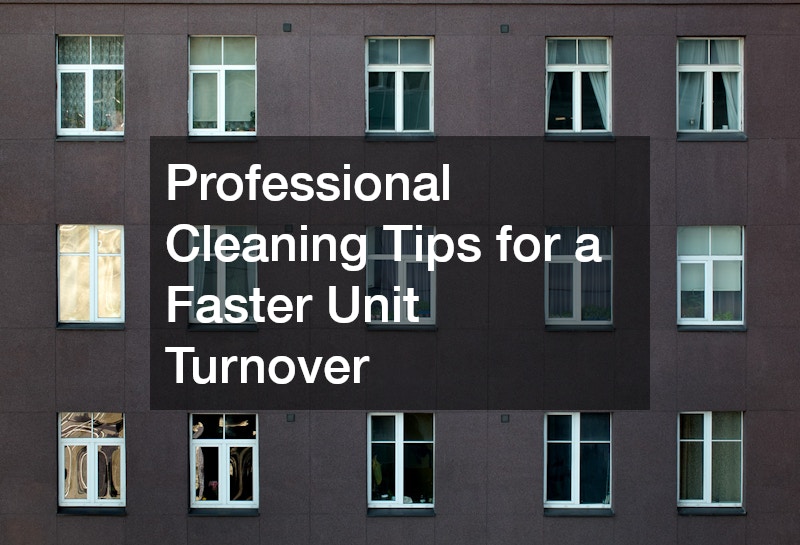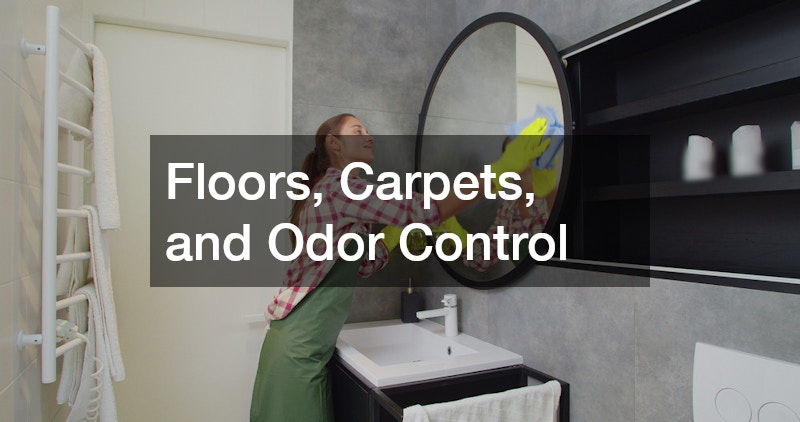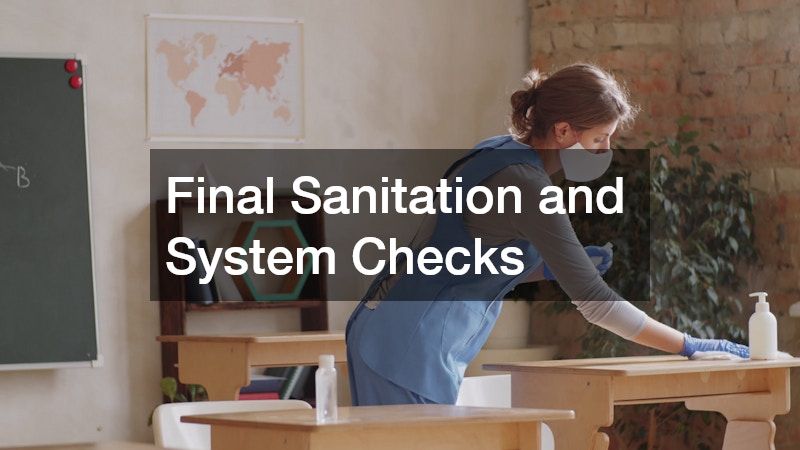Every property manager knows that downtime between tenants equals lost income. A well-executed unit turnover—the process of preparing a rental unit for the next tenant—can reduce vacancy days, increase tenant satisfaction, and preserve property value. The goal isn’t just to make a unit ‘look clean’ but to ensure it’s fully functional, safe, and inviting from top to bottom. Thinking ahead and planning each step of the turnover process can save weeks of unnecessary delays and prevent overlooked issues from becoming expensive repairs.
A professional approach to cleaning during unit turnover involves inspection, minor repairs, deep cleaning, and final presentation. Coordinating with trusted service providers, tackling high-priority maintenance, and following a systematic cleaning routine will help speed up the process without cutting corners. Establishing a repeatable checklist for every turnover ensures consistency, reduces mistakes, and allows teams to work efficiently across multiple units. This guide provides actionable, expert-level advice for property managers and landlords who want to streamline unit turnover efficiently.
Conduct a Full Inspection Before Cleaning
Before grabbing a mop or vacuum, perform a thorough inspection of the unit. Identify damages, worn surfaces, and systems that need attention. Walk through ceilings, walls, floors, windows, doors, bathrooms, kitchens, and storage areas. Document everything with photos and notes, which will guide both repairs and cleaning priorities. Creating a standardized checklist for inspections can save time and ensure nothing is overlooked during unit turnover. Additionally, involve a second team member or assistant to cross-check the checklist and catch items that may be missed during the initial walkthrough.
During this inspection, it’s essential to look at the roof or ceiling for potential leaks. Collaborating with residential roofers at this stage can prevent water damage from affecting interior finishes. Even small leaks can result in stains, mold, or lingering odors, which will slow down the cleaning process if left unaddressed. Also, check for water stains or soft spots on ceilings and walls, which may indicate hidden damage that requires immediate attention. Mark areas that need professional evaluation so that repairs can be scheduled efficiently and avoid delays in the turnover timeline.
Also, check for safety issues, such as loose railings, faulty lighting, or damaged flooring. A proper inspection lays the foundation for a streamlined unit turnover, reducing the risk of delays during tenant move-in. Documenting these safety concerns and scheduling repairs promptly ensures compliance with local building codes and protects tenant safety. Consider creating a severity ranking for each safety issue to prioritize urgent fixes before minor cosmetic repairs.
Prioritize Repairs and Paint Touch-Ups
Once the inspection is complete, tackle necessary repairs immediately. Patch holes, fix damaged trim, replace broken hardware, and address any structural issues. Scheduling these tasks first ensures that cleaning isn’t wasted on areas that will later be repaired or painted. Keep a prioritized list of repairs to ensure the most critical issues are addressed first, which can prevent delays during unit turnover. Document all repairs with photos and notes to track work completion and provide a reference for future turnovers.
A fresh coat of paint can dramatically improve a unit’s appearance. Hiring local painters for touch-ups or full wall applications can save time. Fast-drying, low-VOC paints allow for quicker turnaround without sacrificing quality. Prioritize high-traffic areas, kitchens, bathrooms, and any walls showing significant wear. Also, consider using neutral tones to appeal to a broader range of prospective tenants and make spaces feel larger and cleaner. Test paint patches in small areas first to ensure color consistency and avoid rework.
Timing is key: completing repairs and painting before cleaning prevents accidental smudges and wasted effort. This careful sequencing is essential for efficient unit turnover, helping ensure the unit is ready for tenants as quickly as possible. Coordinate your schedule so painters and cleaners do not overlap, minimizing interruptions and maximizing efficiency. Create a timeline with clear deadlines for each task to keep the turnover on schedule and avoid bottlenecks.
Deep Clean From Top to Bottom
A top-down cleaning approach is the most effective method for professional unit turnover. Start with ceilings, light fixtures, and fans, then move to walls, countertops, cabinets, and floors. Use appropriate cleaning tools: microfiber cloths, steamers, heavy-duty degreasers, and environmentally safe disinfectants. Pay special attention to air vents and ceiling corners where dust accumulates, as these areas are often overlooked but highly visible to tenants. Also, schedule routine inspections of these high areas to prevent buildup and make future turnovers faster and easier.
Exterior maintenance plays a role, too. Scheduling gutter cleaning at this stage prevents water overflow from affecting window sills and foundations, which can lead to mold or staining. Ensuring gutters are free of debris also protects landscaping and hardscaping around the property. Inspect downspouts and splash blocks to make sure water is directed away from the foundation, preventing future damage. Consider trimming overhanging branches and clearing debris from roof edges to further protect gutters and reduce cleaning issues.
Dust, grime, and odors accumulate in areas often overlooked. Thorough cleaning—including corners, vents, baseboards, and window tracks—ensures the unit feels fresh and ready for immediate occupancy, speeding up the unit turnover process. Using a checklist for these hidden areas can help ensure nothing is missed during cleaning, saving time and reducing rework. Label and store cleaning tools and supplies strategically to streamline the process for the next turnover.
Floors, Carpets, and Odor Control
Flooring can make or break a tenant’s first impression. Hard surfaces should be swept, scrubbed, and polished. For carpets, hire a professional carpet cleaning company to steam-clean, deodorize, and remove stains efficiently. Quick-drying methods reduce downtime, which is critical during a tight unit turnover schedule. Check for scratches or chips on hardwood or laminate floors and repair or touch them up to leave a flawless appearance. Also, consider applying a protective finish to high-traffic areas to extend floor life and reduce maintenance between turnovers.
Address odors using natural deodorizers or air purifiers. Ensuring floors are completely dry and free of lingering smells makes the unit more appealing to prospective tenants and prevents post-move-in complaints. Consider placing temporary moisture absorbers in carpeted or high-humidity areas to maintain freshness until move-in. Regularly vacuuming along edges and under furniture during cleaning can help remove hidden dust and maintain a pristine appearance for the next tenant.
Air Quality and Ventilation
Good air quality is vital for tenant comfort and satisfaction. Replace air filters and clean vents thoroughly. Dust and allergens should be removed to create a healthy living environment. Consider using a HEPA vacuum or air purifier during cleaning to remove fine dust and improve overall air quality. Additionally, wipe down HVAC registers and fan blades to prevent dust from recirculating once the unit is occupied.
Coordinate with an HVAC contractor to inspect and service heating and cooling systems. A properly functioning HVAC system ensures air circulation is optimal, odors are minimized, and the unit is comfortable for immediate occupancy. Clean air ducts and functional systems are often overlooked but critical during unit turnover. Also, test thermostats and ensure vents are unobstructed to maintain efficient airflow for the incoming tenant. Scheduling routine maintenance at each turnover can help identify minor issues before they become costly repairs.
Kitchens and Bathrooms — High-Impact Cleaning Zones
Kitchens and bathrooms receive the most scrutiny from tenants. Scrub sinks, countertops, cabinets, tiles, and grout. Disinfect all high-touch surfaces and polish fixtures. Don’t forget to clean behind and under appliances, as hidden grime can impact tenant impressions and hygiene.
While cleaning, schedule local plumbers to inspect for leaks, slow drains, or faulty fixtures. Addressing these issues during unit turnover prevents emergency calls after tenants move in and maintains a professional reputation. Additionally, inspect appliances for wear or damage and make minor repairs. Spotless, functional kitchens and bathrooms leave a lasting impression and increase rental appeal. Also, check caulking and grout for cracks, resealing as needed to prevent water damage and mold growth.
Windows, Fixtures, and Natural Light
Windows and fixtures are critical for unit presentation. Clean all glass surfaces inside and out for streak-free clarity. Dust and polish blinds, sills, and hardware. Also, inspect window locks and screens to ensure safety and functionality for the next tenant, and repair or replace any damaged components promptly. Consider lubricating hinges, locks, and sliding tracks to ensure smooth operation and prevent squeaking or sticking.
During this stage, evaluate whether any windows require window replacement. Drafty, cracked, or fogged windows should be addressed during unit turnover, enhancing energy efficiency and tenant satisfaction. Properly functioning windows also prevent water damage and further cleaning issues down the line. Sealing gaps around windows can help maintain temperature control, improve energy efficiency, and reduce utility costs for tenants. Additionally, check for condensation issues and clean window panes thoroughly to prevent mold or mildew buildup over time.
Appliances and Outdoor Areas
Clean and inspect all appliances, including refrigerators, ovens, washers, dryers, and dishwashers. Wipe down interiors, exteriors, and remove any odors. For any non-functioning items, coordinate appliance repairs to ensure everything is operational for the next tenant. Also, check appliance seals and vents to prevent future issues and ensure energy efficiency. Test each appliance after cleaning to confirm it operates correctly and safely before the tenant moves in.
Outdoor spaces also influence first impressions. Sweep patios, clean entryways, and pressure wash siding or walkways. This creates a cohesive, professional appearance, making the unit feel move-in ready and reducing vacancy time during unit turnover. Consider adding simple outdoor touches like fresh potted plants or a swept walkway to make the property more inviting. Also, inspect fences, gates, and exterior lighting to ensure safety and a well-maintained appearance for prospective tenants.
Exterior and Property Presentation
The exterior presentation complements interior cleanliness. Maintain lawns, remove debris, and tidy up hardscape. Hire hardscaping services if necessary to repair cracked walkways, refresh patios, or update stonework. Consider adding seasonal plants or mulch to boost curb appeal and make the property feel welcoming. Also, inspect exterior lighting and pathways to ensure safety and enhance nighttime visibility for tenants. Regularly sweep and pressure-wash walkways and driveways to maintain a clean, inviting appearance for prospective tenants.
A well-maintained exterior can accelerate tenant interest and reinforce the perception of a well-managed property. Combining interior and exterior prep is essential for completing unit turnover efficiently and effectively. Taking photos after cleanup can also help document the condition for marketing and future inspections. Additionally, check gutters, downspouts, and drainage to prevent water issues that could impact both exterior and interior spaces. Schedule routine inspections of exterior features to catch maintenance issues early and prevent delays in future turnovers.
Final Sanitation and System Checks
Before listing the unit, conduct a final walkthrough. Take a moment to view the space from a tenant’s perspective to catch any overlooked details. Sanitize high-touch surfaces again, check plumbing and electrical systems, and ensure all repairs have been completed. Use a detailed checklist during this walkthrough to confirm that every area meets your move-in readiness standards, reducing the risk of overlooked issues.
For properties with septic systems, coordinate septic pumping as part of the final preparation. This ensures proper functionality and prevents surprises for new tenants. Completing this final step guarantees the unit is fully ready for occupancy and helps maintain a seamless unit turnover process. Additionally, document the final condition with photos or notes to provide a reference for future inspections and tenant move-out comparisons.
A professional approach to cleaning and maintenance is the cornerstone of fast, efficient unit turnover. Coordinating with skilled service providers, following a systematic top-to-bottom cleaning plan, and addressing repairs proactively allows landlords and property managers to minimize downtime, enhance tenant satisfaction, and protect long-term property value. Keeping a documented schedule for each unit turnover can help track progress, identify recurring issues, and streamline future turnovers.
From interior deep cleaning to exterior presentation, every detail matters. By applying these professional tips and maintaining a structured unit turnover routine, rental properties can achieve faster leasing cycles, fewer maintenance headaches, and happier tenants—making your management process smoother and more profitable. Regularly reviewing and updating your turnover procedures based on feedback and experience ensures continuous improvement and long-term efficiency.











